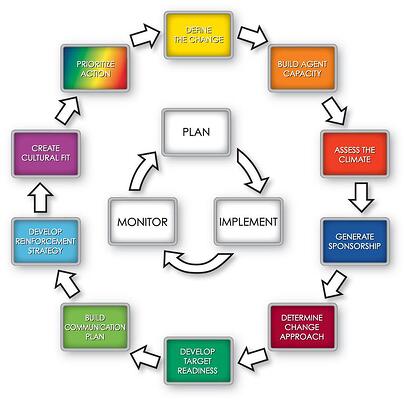Despite the increasing maturity and sophistication around how to manage change projects, there is still one myth out there that seems to sustain itself from the boardroom through senior management ranks: “Just getting planned messages out is enough to not only generate commitment to the change, but to actually have people  change their behavior.” Unfortunately, it’s just not that simple.
change their behavior.” Unfortunately, it’s just not that simple.
When change projects are initiated, organizations spend a great deal of time and money putting together a communication plan. Then, after the project is complete, 9 times out of 10 the #1 complaint from employees is, “we need to communicate better”. What’s going wrong here? Here’s our list of some of the do’s and don’ts for communicating change.
Don’t Mistake a Communication Plan for a Change Management Plan
Based on our 25+ years of helping organizations build speed and capacity for change in their own organizations, we know it is not that simple. Creating a project website and an email campaign are not the same as having a full Change Management Implementation Plan.
Think about it. If you could drive behavior change just by communicating more effectively people wouldn’t smoke and everyone would be at their ideal weight! The truth is, when implementing any change, communication is important... but it’s certainly not enough! {Tweet This}
Do Build a Change Implementation Plan That Fits the Scale and Complexity of Your Change Project
 The structure and deliverables required for your change are dependent on the level of disruption your change will generate. That’s the compelling reason why IMA’s proprietary Accelerating Implementation Methodology (AIM) is not a lock-step protocol, but is designed to be fit for purpose.
The structure and deliverables required for your change are dependent on the level of disruption your change will generate. That’s the compelling reason why IMA’s proprietary Accelerating Implementation Methodology (AIM) is not a lock-step protocol, but is designed to be fit for purpose.
The AIM roadmap includes communication planning, but it is only one of the ten potential elements for implementing organizational change. In fact, the real power-lever in driving sustained behavior change is not communication… it’s changing the reinforcements that motivate people to leave the status quo!
Communication is one area to plan for, but it needs to be integrated with the other “lights on the change dashboard” such as Defining the Change, Generating Sponsorship, Creating Readiness to manage resistance and Developing a Reinforcement Strategy.
Don’t Use a Top Down, One Size Fits All Communication
Does this sound familiar? A Senior Executive sends a message to the entire organization, be it on social media, on the program website or in the monthly newsletter, explaining the “brilliant rationale” behind a change. Obviously, once everyone reads this message they will understand why the change is happening, they will be on board and resistance will be non-existent.
But the reality is resistance to change is unavoidable and it isn’t even all bad, unless it goes unmanaged. Most importantly, sending elegant messages from the top of the chain is certainly not going to stop it.
Do Use “Target Specific” Communication
Instead, communication needs to be targeted, audience-specific, and include a means for gathering feedback from the receivers back to the senders. In other words, all communication must be translated into the Frame of Reference of the Targets, not the Frame of Reference of top managers. Top-down messages are helpful but they need to be married with messages that are right for the Targets who are experiencing the change differently.
Remember, each Target group needs to be considered individually. What is, and what is not changing for that group? What kind of language and examples will resonate for that group?
All communication must address the two most important questions from a Target’s point of view: “What’s in it for me” and “What does it mean to me?” And needless to say, different Target groups will have different answers to those questions!
Don’t Rely Only on Email
Generally speaking, the average business person gets more than 50 emails a day. This fact alone makes it very difficult for emails to have much of an impact.
And, as we've said, it's the reinforcement by managers that provides the most influence on behavior change, not a written message. Think of it like this... no one will change what they are currently doing solely because an email has gone out saying they should!
Do Use a Variety of Communication Means that Include a Feedback Loop
At the beginning of a project, set the expectation that there will be regular communication that is credible and comprehensive. Then follow through with a mixture of the following:
- Small Group Sessions
- One-on-One Meetings
- Focus groups
- Surveys
- Team Meetings
- Hot Lines
- Social Media
Remember, even in today’s technologically-driven world, face-to-face discussion remains the most powerful method for communication. To that end, it is imperative to find as many ways as possible to meet either in small groups or in one-on-one sessions with the Targets of the change. Even if that is by necessity done virtually.
Feedback loops are crucial in order to allow individuals to express their thoughts and feelings about the change. And, it’s a perfect way for Change Agents to gather information about any potential sources of resistance.
“We need to communicate better” is definitely an all too common critique. But by following the above do’s and don’ts, your communication efforts will be centered on sending the right message, to the right audience, at the right time, using the right media. And that’s the right path to effectively communicating change.


